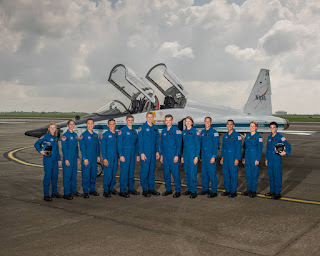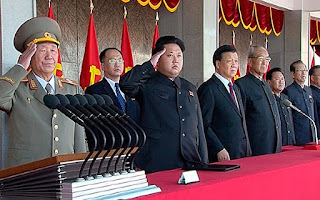The New NASA Hot Shot Astronauts and their Matching Martian Super Rover
The New
NASA Hot Shot Astronauts and their Matching Martian Super Rover
By Stanley Ukeni
Well, it’s official. NASA’s
astronaut class of 2017, chosen from a pool of eighteen thousand three hundred
candidates, includes doctors, scientists, engineers, pilots and military
officers. These seven men and five women are leaders in their respective fields
of profession.
NASA announced its 2017
Astronaut Candidate Class on June 7, 2017. The 12 candidates, pictured here at
NASA’s Ellington Field in Houston, are Zena Cardman, U.S. Marine Corps Maj.
Jasmin Moghbeli, U.S. Navy Lt. Jonny Kim, U.S. Army Maj. Francisco “Frank” Rubio,
U.S. Navy Lt. Cmdr. Matthew Dominick, Warren “Woody” Hoburg, Robb Kulin, U.S.
Navy Lt. Kayla Barron, Bob Hines, U.S. Air Force Lt. Col. Raja Chari, Loral
O’Hara and Jessica Watkins.
Credits: NASA/Robert
Markowitz
“It makes me personally feel
very inadequate when you read what these folks have done,” NASA’s acting chief
administrator, Robert Lightfoot gleefully declared during the induction
ceremony.
These twelve newly inducted candidates
are expected to report to the Johnson Space Center in August to begin their two
years rigorous astronauts training. Upon successful completion of their
training they could, in the not-too-distant-future, be assigned to any number, or variety, of
space missions, which may include extended stays on the International Space
Station (ISS)—and perhaps for inter-planetary exploration.
With the buzz about NASA’s
intention for inter-planetary exploration growing ever louder, this could not
be a better time to be selected as an astronaut trainee. This group of
astronauts may well be among the first group of humans to set foot on an alien
planet, far beyond our moon. So, we may be actually experiencing history in the
making.
They most likely would venture
into deep space aboard United States’ next generation spacecraft like NASA’s
new Orion spacecraft and Space Launch System rocket, to explore humanity’s next
frontier.
The United States Vice
President, Mike Pence, flacked by NASA administrators officially welcomed the
2017 members of the astronaut class to the elite club of professional
spacefarers, during an induction ceremony at the agency’s Johnson Space Center
in Houston, Texas.
During the induction ceremony,
Vice President Pence said, “These are twelve men and women whose personal
excellence and whose personal courage will carry our nation to even greater
heights of discovery and who I know will inspire our children and our
grandchildren every bit as much as your forebears have done so in this storied
American program…”
He further declared, “And to
this newest class of astronauts, it’s my honor to bring the sincere
congratulations of the 45th President of the United States of
America, President Donald Trump. Your President is proud of you, and so am I”.
During the ceremony, the acting
Chief Administrator of NASA, Robert Lightfoot, said, “We look forward to the
energy and talent of these astronauts fueling our exciting future of
discovery.”
He subsequently communicated,
“Between expanding the crew on board the space station to conduct more research
than ever before, and making preparations to send humans farther into space
than we’ve ever been, we are going to keep them busy. These candidates are an
important addition to the NASA family and the nation’s human spaceflight team.”
In the event that any of these men and women become part of the crew of the first NASA manned mission to the planet Mars, or a different planet, they
would need a vehicle to cruise around in the vast expanse of Mars, if they
hope to explore much further than the landing site of their spacecraft.
Luckily, the folks at NASA have
thought of this already. Just recently, NASA’s Kennedy Space Center revealed a
concept, futuristic, exploration vehicle called Mars Rover. The space agency
was excited about its intimidating alien-planetary exploration rover.
With its incredibly
intimidating and futuristic design—and advanced display and control module to
match, this is definitely a rover with attitude. It’s a twenty-first century
version of the manned lunar rover that explored the moon in the 1970s. The
rugged look of this ride would send even the pluckiest Alien Being scurrying
back into their lairs.
Mars Rover was built with an
electric motor drivetrain that draws juice from a compact 700-volt battery that
is connected to solar panels on top of the rover. It is capable of a top speed
of up to 70 mph (around 15mph on Mars).
Hopefully, this is fast enough to out run any menacing sentient Aliens
that are not easily intimidated.
The front navigation section of
the rover is equipped with GPS—so technically, it can be auto controlled from
earth. The rear section of the vehicle is configured to be a research station
for fieldwork, and can separate from the front section if necessary. It is
important to note that this is merely a concept model for earth.
The version that will
eventually make it to Mars would probably look a bit different from this
version on display.
Now, I think it might be
worthwhile for you to acquaint yourself with the profile of these men and women
who might be the first men and women cruising on an alien planet in one of
these Mars Rovers. After all, their future history making endeavors would
captivate a worldwide audience, if any of them become the first humans to step
foot on another planet.
So, with that said, here are
the biographical profiles of NASA’s 2017 astronauts:
Kayla Barron,
29, Lt., U.S. Navy, is originally from Richland, Washington. She graduated from
the U.S. Naval Academy with a bachelor’s degree in systems engineering. A Gates
Cambridge Scholar, Barron earned a master’s degree in nuclear engineering from
the University of Cambridge. As a submarine warfare officer, Barron was a
member of the first class of women commissioned into the submarine community.
She’ll come to NASA from the U.S. Naval Academy, where she has been serving as
the flag aide to the superintendent.
Zena Cardman,
29, calls Williamsburg, Virginia, home. She completed a Bachelor of Science in
Biology and Master of Science in Marine Sciences at The University of North
Carolina, Chapel Hill. Cardman is currently a National Science Foundation
Graduate Research Fellow working on her doctorate at The Pennsylvania State
University. Her research has focused on microorganisms in subsurface
environments, ranging from caves to deep sea sediments. Her field experience
includes multiple Antarctic expeditions, work aboard research vessels as both
scientist and crew, and NASA analog missions in British Columbia, Idaho and
Hawaii.
Raja Chari,
39, Lt. Col., U.S. Air Force, hails from Waterloo, Iowa. He graduated from the
U.S. Air Force Academy with bachelor’s degrees in astronautical engineering and
engineering science. He continued on to earn a master’s degree in aeronautics
and astronautics from Massachusetts Institute of Technology (MIT) and graduated
from the U.S. Naval Test Pilot School. Chari has been serving as the commander
of the 461st Flight Test Squadron and the director of the F-35 Integrated Test
Force at Edwards Air Force Base in California.
Matthew Dominick,
35, Lt. Cmdr., U.S. Navy, was born and raised in Wheat Ridge, Colorado. He
earned a Bachelor of Science in Electrical Engineering from the University of
San Diego and a Master of Science in Systems Engineering from the Naval
Postgraduate School. He also graduated from the U.S. Naval Test Pilot School.
Dominick was at sea on the USS Ronald Reagan, serving as department head for
Strike Fighter Squadron 115, when he got the call saying he’d been selected as
an astronaut candidate.
Bob Hines,
42, considers Harrisburg, Pennsylvania, his hometown. He graduated from Boston
University with a bachelor’s degree in aerospace engineering. From there, he
went on to graduate from the U.S. Air Force Test Pilot School, and then the
University of Alabama, where he earned a master’s degree in aerospace
engineering. He has served in the U.S. Air Force and Air Force Reserves for 18
years. For the last five years, Hines has served as a NASA research pilot at
Johnson.
Warren “Woody” Hoburg,
31, is originally from Pittsburgh, Pennsylvania. He earned a bachelor’s degree
in aeronautics and astronautics from MIT. He continued on to earn a doctorate
in electrical engineering and computer science from the University of
California, Berkley. He is a private pilot and has extensive experience with
wilderness search and rescue efforts. Hoburg will come to NASA from MIT, where
he currently is leading a research group as an assistant professor of
Aeronautics and Astronautics.
Dr. Jonny Kim,
33, Lt., U.S. Navy, was born and raised in Los Angeles. He enlisted in the U.S.
Navy, then trained and operated as a Navy SEAL, completing more than 100 combat
operations and earning a Silver Star and Bronze Star with Combat V. Afterward,
he went on to complete a degree in mathematics at the University of San Diego
and a doctorate of medicine at Harvard Medical School. Kim is a resident
physician in emergency medicine at Massachusetts General Hospital.
Robb Kulin,
33, hails from Anchorage, Alaska. He earned a bachelor’s degree in mechanical
engineering from the University of Denver before going on to complete a
master’s degree in materials science and a doctorate in engineering at the
University of California, San Diego. He has previous experience as an ice
driller in Antarctica on the West Antarctic Ice Sheet and Taylor Glaciers, and
as a commercial fisherman in Chignik, Alaska. Since 2011, Kulin has worked for
SpaceX in Hawthorne, California, where he leads the Launch Chief Engineering
group.
Jasmin Moghbeli,
33, Maj., U.S. Marine Corps, considers Baldwin, New York, her hometown. She
earned a bachelor’s degree in aerospace engineering with information technology
at MIT, followed by a master’s degree in aerospace engineering from the Naval
Postgraduate School. She also is a distinguished graduate of the U.S. Naval
Test Pilot School. Moghbeli currently tests H-1 helicopters and serves as the
quality assurance and avionics officer for Marine Operational Test and
Evaluation Squadron 1 in Yuma, Arizona.
Loral O’Hara,
34, calls Sugar Land, Texas, home. She earned a bachelor’s degree in aerospace
engineering at the University of Kansas and a master’s degree in aeronautics
and astronautics from Purdue University. As a student, she participated in
NASA’s KC-135 Reduced Gravity Student Flight Opportunities Program, the NASA
Academy at the agency’s Goddard Space Flight Center, and the internship program
at NASA’s Jet Propulsion Laboratory. O’Hara is currently a research engineer at
Woods Hole Oceanographic Institution in Woods Hole, Massachusetts.
Dr. Francisco “Frank” Rubio,
41, Maj., U.S. Army, is originally from Miami. He earned a bachelor’s degree in
international relations at the U.S. Military Academy at West Point and a doctorate
of medicine from the Uniformed Services University of the Health Sciences.
Rubio has accumulated more than 1,100 hours of flight time in helicopters,
including 600 hours of combat and imminent danger time. He’s currently serving
as a surgeon for the 3rd Battalion of the Army’s 10th Special Forces Group at
Fort Carson, Colorado.
Jessica Watkins,
29, hails from Lafayette, Colorado. She graduated from Stanford University with
a bachelor’s degree in geological and environmental sciences, then went on to
earn a doctorate in geology from the University of California, Los Angeles.
Watkins has worked at NASA’s Ames Research Center and Jet Propulsion Laboratory
and currently is a postdoctoral fellow at the California Institute of
Technology, where she collaborates on the Mars Science Laboratory rover,
Curiosity.
Authored by E. Stanley Ukeni, ©
2017. All Rights Reserved. This material—except for the biographical profiles
of the astronauts, and other articles or stories posted on this blog site may
not be reproduced, published, broadcast, rewritten or redistributed, in whole
or in part, without prior expressed written permission from the author, E.
Stanley Ukeni.
You are invited to follow E.
Stanley Ukeni on twitter at; @EzStan . You’re equally invited to follow him on
google+. Oh yeah, don’t forget to subscribe to this blog Site. Thanks.
Photo Credit: NASA
Other Credits: Astronauts’
biographical information are from of NASA






Comments
Post a Comment